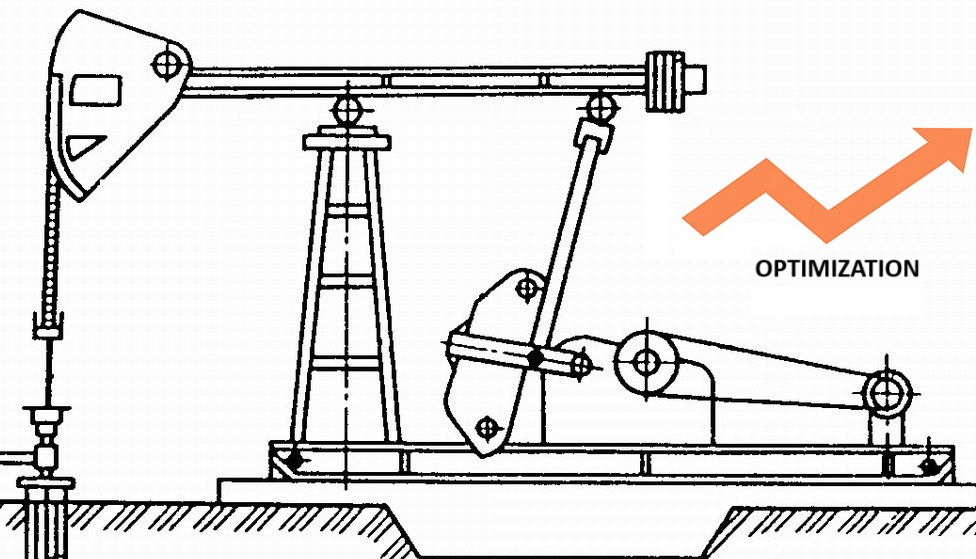Optimization of pump jack electric drive operation taking into account reservoir flow rate
DOI:
https://doi.org/10.15587/2706-5448.2025.322457Keywords:
sucker rod pumping unit, optimization criterion, control system, pump jack, electric drive, well, functionalAbstract
The object of the study are the processes occurring in electric drives of sucker rod pumping units, which are used for mechanical oil production.
When designing oil pumping units, one of the issues is the synthesis of control systems for the electric drives of pump jacks. In the synthesis of the control system, it is important to take into account as many factors as possible that influence the performance of the well and its equipment. When synthesizing the criterion for optimal operation of the system, it is necessary to take into account changes in the technical condition of the oil production facility and the conditions of the reservoir operation. This is implemented using a control system that adjusts the electric drive speed according to the real operating conditions of the well. This approach allows improving the productivity of the oil pumping unit and increasing its economic efficiency.
The main focus is on the synthesis of a control system for the electric drive of a pump jack, which makes it possible to balance the intensity of fluid inflow into the well and its withdrawal. An optimization criterion is proposed, which takes into account different fluid inflow rates, thus adapting the electric drive operation to the specific conditions of each well.
The study used the theory of classical variational calculus. To find the minimum of the functional, and therefore the optimal parameters of the control system, a quadratic form, which is a Lyapunov function, was used.
The study resulted in the formulae for calculating the key operational parameters of the pump jack electric drive. The synthesized optimization criterion links the unit's productivity to parameters such as the number of crankshaft rotations, the rod pump delivery coefficient, and the load torque of the drive motor.
In practice, the proposed optimization criterion for the electric drive operation will enable improving the efficiency of the oil pumping unit through the rational selection of the drive motor's speed and torque. This, in turn, will enhance the well's operating conditions and extend its operational life.
References
- Boiko, V. S. (2004). Rozrobka ta ekspluatatsiia naftovykh rodovyshch. Kyiv: Real Print, 695.
- Liu, T., Tian, X., Liu, L., Gu, X., Zhao, Y., Zhang, L., Song, X. (2022). Modeling the Submergence Depth of Oil Well States and Its Applications. Applied Sciences, 12 (23), 12373. https://doi.org/10.3390/app122312373
- Tan, C., Feng, Z.-M., Liu, X., Fan, J., Cui, W., Sun, R., Ma, Q. (2020). Review of variable speed drive technology in beam pumping units for energy-saving. Energy Reports, 6, 2676–2688. https://doi.org/10.1016/j.egyr.2020.09.018
- Feng, Z.-M., Guo, C., Zhang, D., Cui, W., Tan, C., Xu, X., Zhang, Y. (2020). Variable speed drive optimization model and analysis of comprehensive performance of beam pumping unit. Journal of Petroleum Science and Engineering, 191, 107155. https://doi.org/10.1016/j.petrol.2020.107155
- Peng, L., Zeng-Xiu, Z., Chao, W., Yi-Hui, Z. (2014). Research on Fuzzy PI Control Based on Genetic Algorithms for Beam Pumping Unit. 2014 Fourth International Conference on Instrumentation and Measurement, Computer, Communication and Control. Harbin 72–76. https://doi.org/10.1109/imccc.2014.23
- Barskii, V. A., Kurdiumov, D. S. (2003). Ispolzovanie avtomatizirovannogo reguliruemogo elektroprivoda v sostave stantcii upravleniia shtangovoi glubinno-nasosnoi ustanovki. Vestnik NTU KhPI “Problemy avtomatizirovannogo elektroprivoda. Teoriia i praktika”, 10 (1), 284.
- Li, W., Vaziri, V., Aphale, S. S., Dong, S., Wiercigroch, M. (2021). Energy saving by reducing motor rating of sucker-rod pump systems. Energy, 228, 120618. https://doi.org/10.1016/j.energy.2021.120618
- Pozdeev, D. A., Kudriavtcev, S. V. (2008). Intellektualnaia stantciia ALC800 kompanii ABB dlia upravleniia stankami-kachalkami. Vestnik NTU KhPI “Problemy avtomatizirovannogo elektroprivoda. Teoriia i praktika”, 30, 265–268.
- Elmer, W. G., Elmer, J. B. (2016). Pump Stroke Optimization: Case Study of Twenty Well Pilot. SPE North America Artificial Lift Conference and Exhibition. The Woodlands. Texas. https://doi.org/10.2118/181228-ms
- Lei, D., Huang, X., Zhang, H., Yao, M., Chen, R., Liu, J. (2019). Optimization and Application of Reciprocating Direct-Drive Electric Submersible Plunger Pump Lifting System in the Xinjiang Oilfield. The Open Chemical Engineering Journal, 13 (1), 68–80. https://doi.org/10.2174/1874123101913010068
- Popovych, M. H., Lozynskyi, O. Yu., Klepikov, V. B. et al.; Popovych, M. H., Lozynskyi, O. Yu. (Eds.) (2005). Elektromekhanichni systemy avtomatychnoho keruvannia ta elektropryvody. Kyiv: Lybid, 680.
- Sugimoto, H., Koyama, M., Yano, M., Ohno, E. (1983). A new transfer function of an induction motor driven by variable frequency source. 1983 IEEE Power Electronics Specialists Conference, 102–110. https://doi.org/10.1109/pesc.1983.7069845
- Yuan, R.-S., Ma, Y.-A., Yuan, B., Ao, P. (2014). Lyapunov function as potential function: A dynamical equivalence. Chinese Physics B, 23 (1), 010505. https://doi.org/10.1088/1674-1056/23/1/010505
- Lozynskyi, O. Yu., Lozynskyi, A. O., Marushchak, Ya. Yu. et al. (2016). Syntez liniinykh optymalnykh dynamichnykh system. Lviv: Vyd-vo Lvivskoi politekhniky, 932.

Downloads
Published
How to Cite
Issue
Section
License
Copyright (c) 2025 Andriy Malyar, Mykola Malyar

This work is licensed under a Creative Commons Attribution 4.0 International License.
The consolidation and conditions for the transfer of copyright (identification of authorship) is carried out in the License Agreement. In particular, the authors reserve the right to the authorship of their manuscript and transfer the first publication of this work to the journal under the terms of the Creative Commons CC BY license. At the same time, they have the right to conclude on their own additional agreements concerning the non-exclusive distribution of the work in the form in which it was published by this journal, but provided that the link to the first publication of the article in this journal is preserved.







